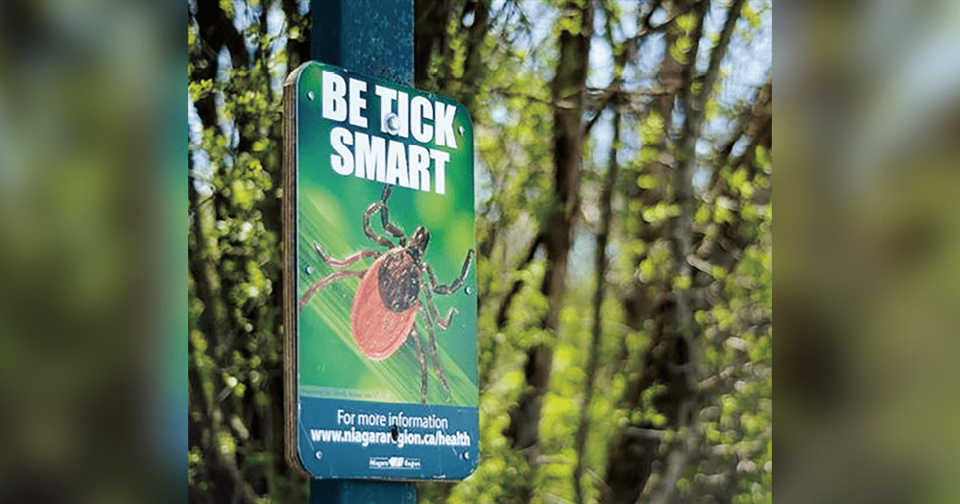Town responds that warning signs about ticks going up next spring
BY JOHN CHICK Special to the VOICE
While in the shower in April 2018, Hurricane Road resident Cristina Savoia discovered a tick —and a bite mark — on her stomach. Concerned, she put the tick in a container and took it to her doctor.
“He felt confident that the tick would not have Lyme disease, and told me to continue my daily routine of walking my dog in the same area because, as he said, ‘There are lots of ticks in Niagara,’” Savoia told the Voice.
Six weeks later —long enough for her to take comfort in the idea that no news is good news —Savoia received a call from her doctor’s office. It wasn’t good news.
“’Sorry to tell you, but the tick you brought in tested positive for Lyme, please come in,’” she said the receptionist told her. “I was livid.”
Savoia, 49, has now been living with Lyme disease for a year and a half, and while she has issues with the way her doctors handled her diagnosis and treatment, she’s also upset that the Town of Pelham hasn’t heeded her warnings about the growing menace.
Savoia is certain she picked up the tick while walking her dog in the Lathrop Conservation Area, north of Highway 20, between Pelham and Haist Streets. To make matters worse, she says than an elderly neighbour on her street is also being treated for Lyme disease.
“Two people on the same block have Lyme in Fonthill,” she said. “That should scare people. I requested signage be installed at Lathrop Conservation Area to inform Pelham citizens of my exposure to Lyme … so they could make an informed decision. They have ignored my requests and have passed me from person to person in the Town without action being taken.”
The Town told the Voice that about 40 signs are scheduled to go up this coming spring.
“About a week ago we received signs from the Region about tick awareness to post for next year,” Communications and Public Relations Specialist Marc MacDonald said last week. “Our park areas currently have signage indicating those spaces are used at your own risk, which would include risk of ticks. They do not specifically reference ticks or Lyme, or any other specific species for that matter.”
MacDonald added that Pelham has been trying to get the word out in other manners.
“As ticks have seemingly become progressively worse over the years, the Town has tried to piggyback on the Region’s message of tick awareness,” he said. “Last year we increased the amount of information for ticks and tick prevention on our social media pages, website, in our newsletter, and other areas.”
Lyme disease is an infectious illness that can cause chronic lifetime problems, with a small mortality rate. It is spread via ticks, and Public Health Ontario has zoned all of Niagara as a risk area for Lyme disease. The eastern part of the peninsula appears to have a higher tick population than the west side, the Region’s Manager of Environmental Health Peter Jekel told the St. Catharines Standard in May.
Pelham, of course, sits right in the middle.
Lyme disease was historically rare in Ontario, with higher infection rates generally seen at lower latitudes in places like Connecticut. However, numbers are on a sharp rise. In 2015, there were some 700 cases of Lyme disease reported to the Public Health Agency of Canada, up from about 130 six years earlier. With continuing climate change believed to be a factor in the proliferation, the federal government allotted $4 million for a national Lyme disease framework in 2017.
Savoia says it’s not enough, and that Ontario’s medical professionals are ill-equipped to deal with the problem.
“I don’t want my current doctor to feel attacked,” she said. “I think he is trying to help, although he’s not sure what the best course of treatment is —which is why he has referred me [to another doctor].” Savoia says she is still waiting for that appointment.
“The first doctor is another story, I am very angry with him.”
Her concerns echo other accounts. In 2017, the CBC reported that it took three months for doctors to diagnose a two-year-old Grey County girl with Lyme disease, despite matching symptoms with a widely available list.
Savoia says her symptoms include fever, fatigue, a slight facial numbness and occasional chest and joint pain. She did not experience a rash at first, but experts say the “bull’s-eye” rash associated with Lyme disease manifests itself in 70-80 percent of patients.
To prevent tick bites, it’s long been advised to wear long pants and sleeves in wooded areas, although that may not come to mind on a humid, 30-degree summer day. People are also advised to use DEET-containing insect repellent and frequently check themselves and their pets for ticks. The Centers for Disease Control also says there are things one can do to “tick-proof” their yard, including removing leaf litter and mowing grass frequently.



